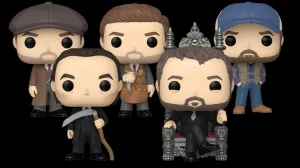
While most of Sony‘s big blockbusters at the PlayStation Experience weren’t in playable form, one game that did have ample opportunity for hands-on was Quantic Dream’s Detroit: Become Human, which is shaping up to be one of the bigger emotional releases for the PlayStation 4. After watching an audience participation activity during Friday night’s presentation, we opted to go hands-on with the game just to see how deep its interaction goes.
Videos by ComicBook.com
The scenario was the same as the one featured in the stage presentation, where you play a young detective android as he’s called upon to stop a fellow replicant from killing a little girl as he stands on the ledge of a skyscraper. The interesting thing about this scenario – and others that are introduced over the course of the game – is that the consequences can change on the flip of a dime, depending on your actions.
For instance, if you go running in and opt to shoot the replicant without getting any background detail, things are not going to end well for you, as he’ll either shoot the girl or drag her over the edge. Likewise, you can try to reach into his emotional core by getting to know what his character is about through research, but that’s not a safe bet either, as there’s a slim chance he may snap and kill her anyway. As mentioned above, it all relies on your choices.
In the demo, we got a chance to do some analyzing of what the character did that led up to the current actions, including locating the father’s gun in a briefcase and shooting the first officer that showed up on the scene. You are then able to recreate these events and catch clues that might have led to his behavior shift, such as a jarring incident that set him off (like someone opting to get rid of said replicant instead of working things out). This in turn gives you background that you can use over the course of your scenario.
Of course, it comes down to action. You can talk to the replicant and try to calm him down, waiving off a helicopter that sits above and even trying to apply to his “human” side, what’s left of it. But, eventually, you’ll have to make some rough decisions that could either work in your favor, or…don’t.
That’s the interesting thing about Detroit: Become Human. Not all of the events may go in your favor, but it’s still fascinating to see how choices define your character. Even smaller things, like saving a fish that fell out of a fish tank, can make all the difference.

The interactivity is pretty sharp, as we’ve seen in previous Quantic Dream releases like Beyond: Two Souls and Heavy Rain, but the atmospheric design is off the charts, with levels of beauty that we’ve only seen in sci-fi fare like Blade Runner. It definitely looks like a dystopian future, but at least there’s a little hope here – even if the androids may not be all that they seem, as you’ll see in later scenarios of the game.
We’ll see how Detroit: Become Human fares when the game releases in 2018 for PlayStation 4.








